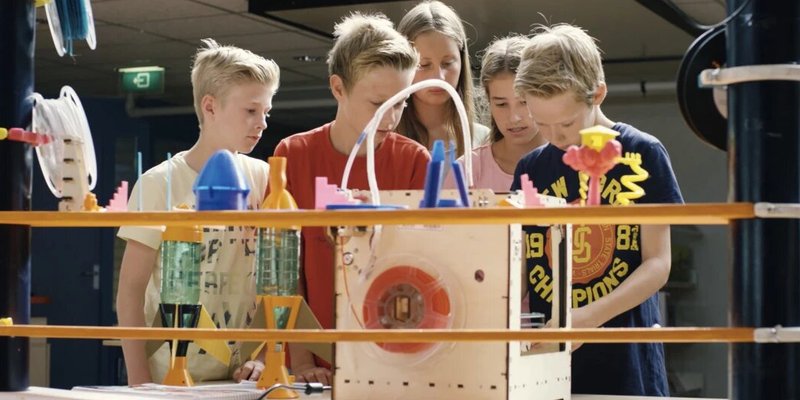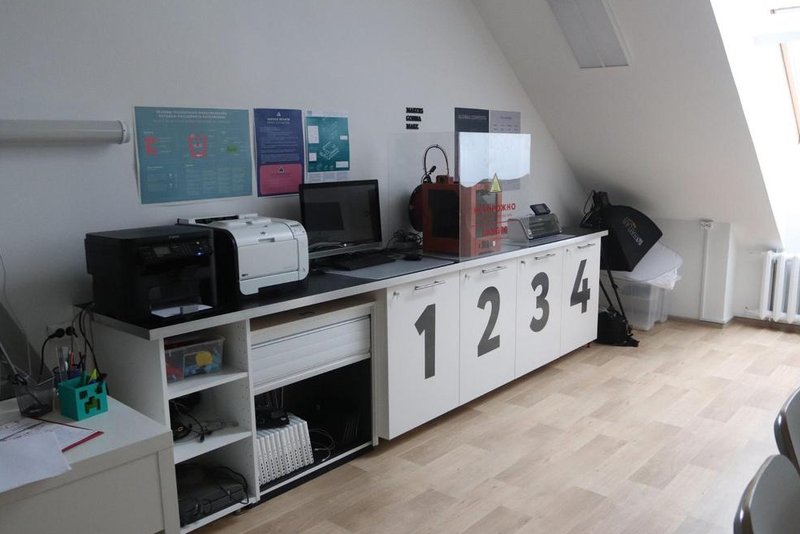
Hi everyone! Today, we’re going to talk about using 3D printers and 3D printing technologies in education.

Source: lpfrg.com
It’s been a while since 3D printers stopped being expensive tools affordable only to big companies and leading research centers. These days, even a kid can use a 3D printer, and the prices of the devices start at a mere several hundred dollars. Using 3D printing technologies revolutionizes teaching methods and takes the students’ creative development to a new level.

Source: all3dp.com
The 3D technologies can be used at every stage of education, from the junior schools to the universities. And that’s even without considering the fact that teaching almost every discipline is going to be easier with 3D printing. As an example, a physics teacher can ask the students to create a functional 3D model of a rocket while explaining the working principles of reaction engines. And a geography teacher can ask them to print a 3D model of some place of the world which will help the kids to understand the region better. This makes the learning process more interesting and the new knowledge more sound.

Source: ultimaker.com
It’s possible to highlight five main advantages of using 3D printing in education:
1. Teaching STEM
The 3D printing technology nurtures creators in the students. Instead of buying or utilizing ready to use products, they become inventors that define their needs and find the solutions, creatively combining their knowledge and the skills of handling the equipment.
3D printing is the technology that scientists and engineers use to change the world. Sharing this knowledge with the students will allow them to recognize the problems that society faces and get the skills that will be useful in further learning and getting a profession.
2. The development of imagination and creativity
With 3D printing, the art steadily reconnects with the technology, and the students become designers and artists. They use the latest technologies to visualize the products of their imagination. Spatial thinking and the ability to design and realize the ideas are developed during studying.
3. Attracting “lazy” students
3D printing is still a very new technology that is not always accessible to an average consumer. This is why it has a “wow factor” that will attract the students that usually don’t care about studying. Access to 3D printing technologies is a great way to motivate the students that are behind in other disciplines.
4. Nurturing social skills
Using 3D printing in class will allow the students to become a part of the growing online community focused on this technology. It will allow them to review and comment on the products of their peers, to be tolerant of their mistakes and learn from the best examples.
The connection between the different grades, a unity of junior and senior students working together over a 3D project will allow the older students to be good teachers and value the respect that the younger ones show.
5. Cultivating determination
With the help of 3D printing, everything can be realized in practice. A model of a mummy or a pyramid can be printed to help the students delve into the world of the ancient societies. If a student is dreaming of travel, then a treasure island or mountain’s peak can be printed. If a kid wants to protect a city from natural disasters, then a flood control dam can be developed, printed, and immediately tested. The list of opportunities never ends, it’s just important not to stop at the stage of an idea, but to make one come to life.
The students will find out that it’s perfectly acceptable to fail at the first try and get better after trying again. Once they understand that the failures are a part of the process, they will become less scared of bringing new and various ideas to life. This will make them more assured, while the teachers will enjoy seeing the students motivated.

Source: all3dp.com
Regardless of the stage of education, there are some key points to consider when getting a 3D printer to the institution:
Safety. It’s important to remember that the printers will be operated by the users without any experience who also want to touch everything. The FDM/FFF 3D printers have a print head that can heat up to the temperatures between 100 and 500 °C, while the photopolymer resin of the SLA/DLP/LCD printers is difficult to wash away. So the logical choice would be to get a 3D printer with an enclosed print chamber. Please note that the printers usually give off the fumes that aren’t always harmless, so the devices used for educational purposes will need to have the air filters installed.
The price. No matter how many safety measures a teacher would take, the chances of breaking things while learning are still high, and the repair might become costly. It the device is inexpensive, it might be easier to get a new one or replace a significant part.
Simple construction. The simpler, more rigid and reliable the design of the printer is, the less are the chances that this expensive equipment will break due to incorrect manipulations.
The availability of consumables. As much as one would want to use the expensive proprietary materials for getting perfect prints, it’s still important to remember the main purpose: education. And it means that there will always be failed prints, material consumption will always be high and the printer should be able to work with the cheapest and most common of them.
Service and maintenance. Convenient repair and replacement of parts. Learning is a continuous process, and closely located official dealership and service center can help to save time and money.
Using free software. Initial training doesn’t aim to turn a user into a professional. A teacher should give basic knowledge to a student as well as the interest to pursue it further. Using complex professional software packages is not only expensive, but also could make an inexperienced user doubt their own abilities.
Manufacturer-provided training courses. Many 3D manufacturers that are interested in promoting their own products, release special training courses for both students and teachers. These can help to avoid many mistakes and improve the efficiency of studying.
Manufacturer-provided motivational programs. Some companies offer grant support programs that motivate most talented teachers and students.

Source: ultimaker.com
What is the minimum age to start learning about 3D technologies? It’s the age when a young person is able to understand the connection between their actions and the results. The majority have heard about intelligence quotient (IQ) and emotional quotient (EQ). These are the methods to measure the intellectual and emotional abilities of a person.

Source: ultimaker.com
The 3D technologies allow us to develop another side — spatial intelligence or the ability to manipulate 2D and 3D objects, that starts to form from a very early age. A study conducted by the group of scientists led by David Lubinski from the Vanderbilt University that lasted for several decades, showed that the spatial intelligence is a predictor of the ability to accumulate knowledge, especially in the STEM fields.
Lubinski and his colleagues have found out that this type of intelligence is always ignored in modern educational systems and testing methods. They think that helping the students to develop their spatial intelligence is the key to make people smarter. Lubinski has noted that spatial abilities can be the biggest of known unused sources of human potential.

Sources: lpfrg.com
Universities perfect the knowledge that the students learned in school and also give special skills that are needed to get a profession. Moreover, they can be the centers of research and development of new technologies. Using 3D printing speeds up these processes. Medical students can use the technology to print human organs, getting a better knowledge of anatomy, while the technology students can rapidly prototype new products. The students that study design and architecture can also print their models.

Private Lomonosov School in Nizhny Novgorod is one of few Russian schools that offer International Baccalaureate — Primary Years Programme, Middle Years Programme. Not only do the graduates get government-issued certificates but they also receive one that allows them to enroll in the universities internationally.

The school got the Russian-made Hercules 3D printer at Top 3D Shop with the purpose of teaching kids modern technologies. The device passes all of the safety requirements and allow the students to monitor the printing process and understand the working principles of 3D printing.

This school is for students that show outstanding abilities in tech-related fields and arts. It offers special educational programs that utilize modern equipment and provide the students not only with the basic school skills but also with enough competency to interact with modern production.

Top 3D Shop set up the desktop 3D printers PICASO 3D Designer XPRO (FDM), resin 3D printer Formlabs Form 2, full-color ProJet 260Plus and other additional equipment in the school. The arrival of modern technologies to the school allowed the teachers to create educational tools and organize a modeling and prototyping class, so the kids can show their engineering and creative abilities.

Source: manipulativecalculus.com
Multivariable calculus is the biggest mathematical course at Harvard University and is a prerequisite for all of the STEM studies. It’s the first mathematical course for the majority of the students. It includes 3D calculations and visualization. The team that develops the learning programs at Harvard University has decided that the best way to teach this discipline is to hand everything over to the students. Literally.

Source: manipulativecalculus.com
The new part — an active interaction with the 3D models — was integrated into the program in 2017. Since 2018, this course doesn’t consist of lecturers but is studied in groups of 30 and fewer students, assuring that there will be enough copies of the object. The new course is called “Manipulative Calculus”. All of its models are 3D printed.
Experience has shown that not only do the students understand the learning material better while using the 3D models, but also the teachers become better at rating the students’ knowledge.

Moscow Aviation Institute is the biggest university in Russia for training future scientists and engineers for the aerospace industry. In 2018, MAI took a good place at the rankings of the best universities by Times Higher Education.

A team of scientists and the students had to make the accurate exhibition stand replicas of the manned spacecraft “Soyuz TMA-M” and “Soyuz-FG” for using those as the educational tools. They decided to use 3D printing technology and SolidWorks software.

Thanks to the experts of Top 3D Shop and such printers as Anycubic Photon S, Phrozen Shuffle 2019, Formlabs Form 3, Picaso3D Designer XPRO and Hercules Strong 3D, the models were created with perfect accuracy.
Aside from the spacecraft, we have also printed a model of launch facilities for the Moscow Aviation Institute.

Source: edtechmagazine.com
The advantages of using 3D printing technology, 3D printers, and 3D modeling in education are obvious — not only do they allow for easier learning of traditional disciplines but also provide the specific knowledge and skills that are currently in demand and can be useful for further studying and in practice. More educational institutions start to understand that and regard the digital and additive technologies as something that will play a huge role in preparing the students for adulthood. The manufacturers of the 3D equipment start to notice the tendency and offer more programs and products specifically for educational purposes.
Give the students a better future with the help of Top 3D Shop — the company with the expertise of integrating 3D equipment into education programs.
Update your browser to view this website correctly. Update my browser now
Write a comment